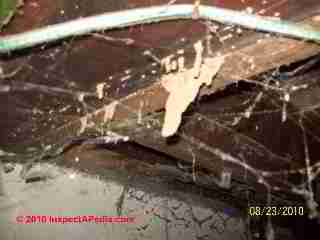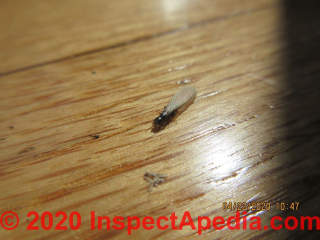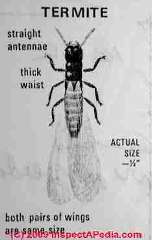 Termite Generated Naphthalene Hazards
Termite Generated Naphthalene Hazards
Health risks of naphthalene; removal of naphthalene or "mothball" odors
- POST a QUESTION or COMMENT about mothball or naphthalene chemicals, hazards, odors, & odor removal
Naphthalene odors may be caused by termites rather than from moth flakes or mothballs, and may be unsafe.
Here we describe the detection of and risks of exposure to mothball chemicals & odors when moth repellent products are applied indoors in buildings.
In this article series we describe the sources of mothball or naphthalene odors and give advice on how to get rid of mothball odors in buildings, building furnishings, clothing, or vehicles.
Page top photo, courtesy of Wikipedia commons, shows a cluster mothballs, or a solid form of naphthalene.
InspectAPedia tolerates no conflicts of interest. We have no relationship with advertisers, products, or services discussed at this website.
- Daniel Friedman, Publisher/Editor/Author - See WHO ARE WE?
Termites & Other Natural Sources of Naphthalene: Possible Hazards to Humans
 First reported by Chen in 1998, termites produce naphthalene (NPH) (in some spellings, napthalene) or possibly other volatile chemicals (fenchone) or polycyclic aromatic hydrocarbons (PAHs), as an insect repellent, in the course of building mud tubes and termite nests, including termite infestations in the wood components of some buildings. (Chen 1998, Bandowe 2009, Wilcke 2000).
First reported by Chen in 1998, termites produce naphthalene (NPH) (in some spellings, napthalene) or possibly other volatile chemicals (fenchone) or polycyclic aromatic hydrocarbons (PAHs), as an insect repellent, in the course of building mud tubes and termite nests, including termite infestations in the wood components of some buildings. (Chen 1998, Bandowe 2009, Wilcke 2000).
Photo: a swarming, winged termite emerging from a hardwood floor of a termite-infested home.
[Click to enlarge any image]
Etymologists pose that a "natural" production of naphthalene by termites has the function of protecting the termite colony from their predators including some species of ants, bacteria, soil fungi, and microscopic nematode worms.
When a building has suffered significant termite infestation and damage, is it possible that the human (or other animal) occupants of the building will be exposed to significant naphthalene gases in building air without ever realizing that such exposure is taking place?
Possibly. (Though in our opinion and based on research to date, probably not).
Really? Termite-produced naphthalene off-gassing in buildings has been posed, somewhat speculatively in our opinion, as a health risk for people.
Researching termite and other natural sources of naphthalene in buildings, we found research confirming that naturally-generated naphthalene in termite nests, particularly formosan termite nests, occurs.
Naphthalene in termite nests probably serves to benefit the termites by discouraging the growth of some fungi and possibly by discouraging nematodes or other worms.
However, we have not found scholarly nor other authoritative research documenting that the (probably trace) levels of naphthalene that might be produced by termites infesting as building have actually been found to cause human illness.
Watch out: other human illnesses that might correlate with termite or other wood destroying insect infestation in buildings could include irritating airborne particles causing or contributing to asthma attacks, and pesticide poisoning from amateur or improperly applied chemicals or pesticides in or around the building.
See PESTICIDE EXPOSURE HAZARDS.
Other natural sources of naphthalene can include Muscodor vitigenus, an endophytic fungus (Daisy 2002).
Also see TERMITE IDENTIFICATION & CONTROL
Termite & Other Natural Sources of Naphthalene in Buildings
- At RESEARCH on NAPHTHALENE HEALTH HAZARDS we include research on the health effects of naphthalene poisoning.
- Bandowe, Benjamin A. Musa, Daniel Rückamp, Marcos AL Bragança, Volker Laabs, Wulf Amelung, Christopher Martius, and Wolfgang Wilcke. "Naphthalene production by microorganisms associated with termites: evidence from a microcosm experiment." Soil Biology and Biochemistry 41, no. 3 (2009): 630-639.
Abstract:
Abstract
There have been several reports published which suggest that it is possible that the polycyclic aromatic hydrocarbons (PAHs) naphthalene (NAPH), phenanthrene (PHEN) and perylene (PERY) in tropical environments have a biological source.
This source might be related to the activity of termites or their associated microorganisms.
We aimed to provide direct evidence for the biological production of NAPH, PHEN and PERY by conducting microcosm experiments in the State of Tocantins, Brazil, in which termite nests (with or without termites) were placed in an enclosed environment in which we controlled all PAH fluxes and monitored changes of PAH stocks.
The experiments were carried out with termites from a tropical floodplain forest environment at the Estação Canguçu (Ilha do Bananal) in the State of Tocantins, Brazil.
We set up the following treatments: live nest of Nasutitermes cf. minor using PAH-poor wood as food (LNW), live nest of Nasutitermes cf. minor using PAH-poor corn as food (LNC), termite nest without live termites called dead nest (DNC) and dead nest with additional treatment by a combined fungicide/bactericide (FDN) in several replicates.
...
Our microcosm experiments suggest that NAPH can be produced by fungi and bacteria in termite mounds while all other low-molecular weight PAHs are degraded in microcosms with live termite nests. PAH degradation seems to be enhanced by the combined activity of termites and microorganisms. - Chen, J., G. Henderson, C. C. Grimm, S. W. Lloyd, and R. A. Laine. "Termites fumigate their nests with naphthalene." Nature 392, no. 6676 (1998): 558.
- Chen, Jian, Gregg Henderson, Casey C. Grimm, Steven W. Lloyd, and Roger A. Laine. "Naphthalene in Formosan subterranean termite carton nests." Journal of agricultural and food chemistry 46, no. 6 (1998): 2337-2339.
Abstract:
Termite nests provide a controlled environment and physical defence for the colonies of insects they house1.
Another important factor involved in colony defence may be volatile chemicals present in the nest: we have found the hydrocarbon naphthalene in extracts of the nest material produced by Formosan subterranean termites.
This is the first time naphthalene has been found naturally associated with any insect species. - Daly, Gillian L., Ying D. Lei, Luisa E. Castillo, Derek CG Muir, and Frank Wania. "Polycyclic aromatic hydrocarbons in Costa Rican air and soil: A tropical/temperate comparison." Atmospheric Environment 41, no. 34 (2007): 7339-7350.
- Daisy, Bryn H., Gary A. Strobel, Uvidelio Castillo, David Ezra, Joe Sears, David K. Weaver, and Justin B. Runyon. "Naphthalene, an insect repellent, is produced by Muscodor vitigenus, a novel endophytic fungus." Microbiology 148, no. 11 (2002): 3737-3741.
Abstract:
Muscodor vitigenus is a recently described endophytic fungus of Paullinia paullinioides, a liana growing in the understorey of the rainforests of the Peruvian Amazon. This fungus produces naphthalene under certain cultural conditions.
Naphthalene produced by M. vitigenus was identified by gas chromatography/mass spectrometry. Its chromatographic and mass spectral properties were identical to authentic naphthalene.
Agar plugs supporting growth of the fungus and producing known amounts of naphthalene effectively repelled the adult stage of the wheat stem sawfly, Cephus cinctus, in Y-tube bioassay tests. Authentic naphthalene, at comparable concentrations to those in tests involving the fungus itself, mimicked the insect repellency of the fungus.
Although other Muscodor spp. produce volatile antimicrobials, M. vitigenus is unique in its ability to produce naphthalene almost exclusively. This report also describes the potential practical implications of M. vitigenus. - Girschikofsky, Maiko, Manuel Rosenberger, Stefan Belle, Malte Brutschy, Siegfried R. Waldvogel, and Ralf Hellmann. HIGHLY SENSITIVE DETECTION OF NAPHTHALENE IN SOLVENT VAPOR USING A FUNCTIONALIZED PBG REFRACTIVE INDEX SENSOR [PDF] Sensors 12, no. 2 (2012): 2018-2025.
Abstract:
We report an optical refractive index sensor system based on a planar Bragg grating which is functionalized by substituted γ-cyclodextrin to determine low concentrations of naphthalene in solvent vapor. T
The sensor system exhibits a quasi-instantaneous shift of the Bragg wavelength and is therefore capable for online detection. The overall shift of the Bragg wavelength reveals a linear relationship to the analyte concentration with a gradient of 12.5 ± 1.5 pm/ppm.
Due to the spectral resolution and repeatability of the interrogation system, this corresponds to acquisition steps of 80 ppb. Taking into account the experimentally detected signal noise a minimum detection limit of 0.48 ± 0.05 ppm is deduced. - Grace, J. Kenneth. "APPROACHES TO BIOLOGICAL CONTROL OF TERMITES." [PDF] Sociobiology 41, no. 1 (2003): 115-122. Retrieved 2018/04/10, original source: https://www.researchgate.net/profile/Benjamin_Bandowe/publication/268212198_Persistent_organic_pollutants_in_soil_sources_concentrations_and_fate/links/5467268b0cf20dedafcdab75.pdfhttps://www.ctahr.hawaii.edu/gracek/pdfs/190.pdf
- Musat, Florin, Alexander Galushko, Jacob Jacob, Friedrich Widdel, Michael Kube, Richard Reinhardt, Heinz Wilkes, Bernhard Schink, and Ralf Rabus. "Anaerobic degradation of naphthalene and 2‐methylnaphthalene by strains of marine sulfate‐reducing bacteria." Environmental Microbiology 11, no. 1 (2009): 209-219.
- Nash, L. Frazer. "Naphthalene poisoning." The British Medical Journal (1903): 251-251.
- Pyenson, Louis, and G. F. MacLeod. "THE TOXIC EFFECTS OF NAPHTHALENE ON BRUCHUS OBTECTUS AND TENEBRIO MOLITOR IN VARIOUS STAGES OF DEVELOPMENT." [PDF] Journal of Agricultural Research 52, no. 9 (1936). Retrieved 2018/04/10 original source: https://naldc.nal.usda.gov/download/IND43968869/PDF
Introduction Excerpt:
Although naphthalene has been in use as an insecticide for about 50 years, knowledge of its toxic effects is based mainly on investigations conducted under uncontrolled conditions.
Very little is known of the physiological effects of naphthalene on insects. In late years naphthalene has been found useful against an increasing variety of insect pests, but it is probably most effective in killing or repelling insects found in houses, greenhouses, stored products, and in the soil. - TERMITE IDENTIFICATION & CONTROL information at InspectApedia.com
- U.S. CDC "Chapter 4: DISEASE VECTORS & PESTS, [PDF] U.S. Centers for Disease Control and Prevention, retrieved 2018/04/14, original source: https://www.cdc.gov/nceh/publications/books/housing/cha04.htm -|
- Wilcke, Wolfgang, and Benjamin Bandowe. "PERSISTENT ORGANIC POLLUTANTS IN SOIL: SOURCES, CONCEN-TRATION, AND FATE." [PDF] Bull. BGS 32 (2011): 33-38.
Abstract excerpt:
Persistent organic pollutants (POPs) are a legacy of industrialization resulting in long-term contamination of the environment. The purpose of our paper is mainly to describe open questions in the understanding of the fate of POPs in the soil environment and the resulting future research directions. - Wilcke, Wolfgang. "Global patterns of polycyclic aromatic hydrocarbons (PAHs) in soil." Geoderma 141, no. 3-4 (2007): 157-166.
Abstract excerpts:
Recent findings suggest a higher natural contribution to PAH concentrations in soil than previously thought. I hypothesized that the PAH pattern in soil is dominated by two main types, which are indicative of background conditions on the one side (i.e., by biological and diffuse PAHs) and a strong impact by atmospheric deposition of anthropogenic emissions on the other side.
... These results support the hypothesis that PAH mixtures in soils are dominated by two major source patterns, a background and a human-made one. - Wilcke, Wolfgang, Martin Krauss, and Wulf Amelung. "Carbon isotope signature of polycyclic aromatic hydrocarbons (PAHs): evidence for different sources in tropical and temperate environments?." Environmental science & technology 36, no. 16 (2002): 3530-3535.
- Wilcke, Wolfgang, Wulf Amelung, Christopher Martius, Marcos VB Garcia, and Wolfgang Zech. "Biological sources of polycyclic aromatic hydrocarbons (PAHs) in the Amazonian rain forest." Journal of Plant Nutrition and Soil Science 163, no. 1 (2000): 27-30.
Abstract:
Hazardous polycyclic aromatic hydrocarbons (PAHs) widely occur in the environment and are believed to be mainly anthropogenic. Here we present strong indications for large biological sources of the PAHs naphthalene, perylene, and possibly also phenanthrene in the Amazonian basin.
Termite nests, plant wood, and soils were sampled. Naphthalene is detected in plant wood and is accumulated in the nests of termites from the genus Nasutitermes. Perylene is found in all studied termite nests including six different genera. Phenanthrene occurs at substantial concentrations in wood, soil, and termite nests. - Wright, Maureen S., Alan R. Lax, Gregg Henderson, and Jian Chen. "Growth response of Metarhizium anisopliae to two Formosan subterranean termite nest volatiles, naphthalene and fenchone." Mycologia (2000): 42-45.
Abstract Excerpts:
The entomopathogenic fungus Metahizium anisopliae (Metschnikoff) Sorokin was inveestigated as a control agent against the Formosan subterranean termite, Copotermes formosanus Shiraki. Metahizium anisopliae is a known insect pathogen and its effectiveness against termite species has been demonstrated.
Use of this fungus in an integrated pest management scheme may be effective. In order to function i nthis manner, M. anisopliae must withstand the environment of a Formosan Subterranean termite nest, including the presence of the volatile chemicals naphthalene and fenchone.
These chemicals have been identified from Formosan termite nests, but their significance, if any, in a termite society is unknown. ...
Note: Termites get notice in this article but naphthalene generated by termites or from other sources is not mentioned.
...
Continue reading at MOTHS, MOTHBALL ODORS or select a topic from the closely-related articles below, or see the complete ARTICLE INDEX.
Or see these
Recommended Articles
- INSECT INFESTATION / DAMAGE - home
- MOTHS, MOTHBALL ODORS - home
- MOTHBALL ODOR IMPACT on REAL ESTATE SALES
- NAPHTHALENE POISONING SYMPTOMS
- NAPHTHALENE HEALTH HAZARD RESEARCH
- NAPHTHALENE / PARABENTIOL OFF-GAS TESTING
- ODORS GASES SMELLS, DIAGNOSIS & CURE - home
- PESTICIDE EXPOSURE HAZARDS
- POWDER POST BEETLES & CARPET BEETLES - control, fumigation
- SMELL PATCH TEST to FIND ODOR SOURCE
- TERMITE IDENTIFICATION & CONTROL - home
- TERMITES & NAPHTHALENE HAZARDS
Suggested citation for this web page
TERMITES & NAPHTHALENE HAZARDS at InspectApedia.com - online encyclopedia of building & environmental inspection, testing, diagnosis, repair, & problem prevention advice.
Or see this
INDEX to RELATED ARTICLES: ARTICLE INDEX to BUILDING ODOR DIAGNOSIS & CURE
Or use the SEARCH BOX found below to Ask a Question or Search InspectApedia
Or see
INDEX to RELATED ARTICLES: ARTICLE INDEX to INSECT DAMAGE
Or use the SEARCH BOX found below to Ask a Question or Search InspectApedia
Ask a Question or Search InspectApedia
Try the search box just below, or if you prefer, post a question or comment in the Comments box below and we will respond promptly.
Search the InspectApedia website
Note: appearance of your Comment below may be delayed: if your comment contains an image, photograph, web link, or text that looks to the software as if it might be a web link, your posting will appear after it has been approved by a moderator. Apologies for the delay.
Only one image can be added per comment but you can post as many comments, and therefore images, as you like.
You will not receive a notification when a response to your question has been posted.
Please bookmark this page to make it easy for you to check back for our response.
IF above you see "Comment Form is loading comments..." then COMMENT BOX - countable.ca / bawkbox.com IS NOT WORKING.
In any case you are welcome to send an email directly to us at InspectApedia.com at editor@inspectApedia.com
We'll reply to you directly. Please help us help you by noting, in your email, the URL of the InspectApedia page where you wanted to comment.
Citations & References
In addition to any citations in the article above, a full list is available on request.
- In addition to citations & references found in this article, see the research citations given at the end of the related articles found at our suggested
CONTINUE READING or RECOMMENDED ARTICLES.
- Carson, Dunlop & Associates Ltd., 120 Carlton Street Suite 407, Toronto ON M5A 4K2. Tel: (416) 964-9415 1-800-268-7070 Email: info@carsondunlop.com. Alan Carson is a past president of ASHI, the American Society of Home Inspectors.
Thanks to Alan Carson and Bob Dunlop, for permission for InspectAPedia to use text excerpts from The HOME REFERENCE BOOK - the Encyclopedia of Homes and to use illustrations from The ILLUSTRATED HOME .
Carson Dunlop Associates provides extensive home inspection education and report writing material. In gratitude we provide links to tsome Carson Dunlop Associates products and services.


